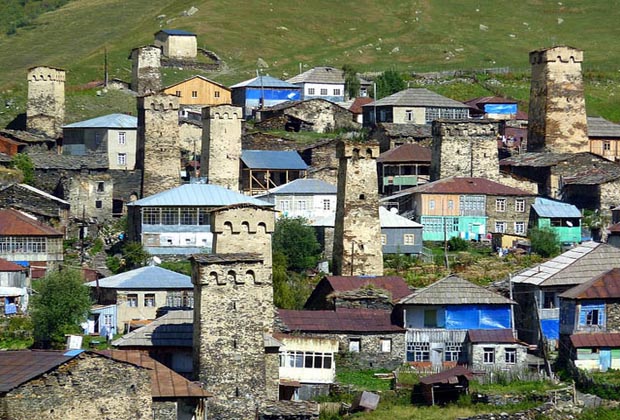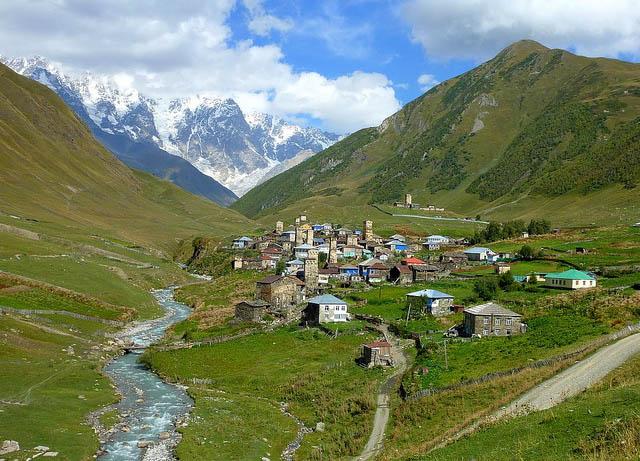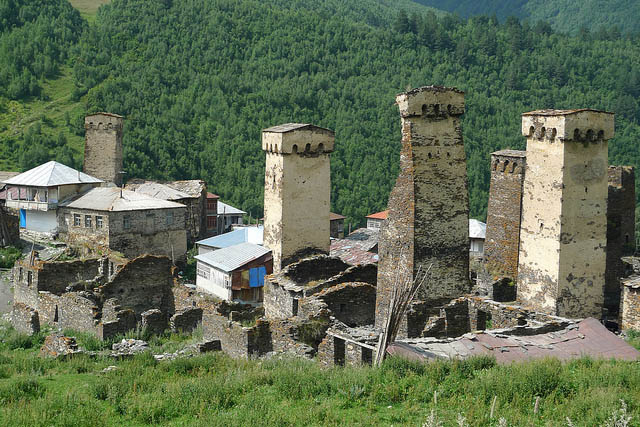Preserved by its long isolation, the Upper Svaneti region of the Caucasus is an exceptional example of mountain scenery with medieval-type villages and tower-houses. The village of Chazhashi still has more than 200 of these very unusual houses, which were used both as dwellings and as defence posts against the invaders who plagued the region. Upper Svaneti is an exceptional landscape that has preserved to a remarkable degree its original medieval appearance, notable for the distribution, form, and architecture of its human settlements.
 |
| The village of Chazhashi in Svaneti, Georgia |
The earliest references to Svaneti occur in the works of Strabo (66 BC-AD 24), when it had already been settled for many generations and had achieved a high level of culture. From the 4th century AD it was a vassal-state of the Kingdom of Lazika. In the 8th century the Abkhaz Kingdom was established in western Georgia, to be in its turn absorbed into the united Kingdom of Georgia that was finally consolidated by David the Builder (reigned 1089-1125). A strong movement for Svan independence developed, and its feudal lords often chose the side of forces opposed to the Georgian state. This did not hinder the political and economic growth of Georgia, which spread to cover much of the region between the Black and Caspian Seas under George II and his daughter Tamar in the succeeding centuries. This was accompanied by a cultural flowering, of which Svaneti was one of the main centres, famous for its schools of metalwork, painting, wood carving, and architecture. These skills were employed by the Church, which was also rich and powerful in this period; most of the churches in Upper Svaneti date from this period. Although not affected by the catastrophic Mongol invasion, Svaneti found itself increasingly isolated, and as a result its economy and culture declined in the 15th-18th centuries. Part of Svaneti was eventually overrun by Princess Dadeshkeliani in the 15th century, but further inland, on the upper reaches of the Inguri River, the people of Upper Svaneti preserved their independence, with Mestia as their capital, until the coming of the Russians in the 19th century.
The mountainous region of Upper Svaneti occupies the upper reaches of the lnguri river basin, between the Caucasus and Svaneti ranges. The characteristic landscape of Upper Svaneti is formed by small villages, dominated by their church towers and situated on the mountain slopes, with a natural environment of gorges and alpine valleys and a backdrop of snow-covered mountains. The most notable feature of the settlements is the abundance of towers, especially in Mestia and the frontier villages, such as Ushguli and Latali. These towers usually have from three to five storeys and the thickness of the walls decreases, giving the towers a slender, tapering profile. The houses themselves are usually two-storeyed; the ground floor is a single hall with an open hearth and accommodation for both people and domestic animals, the latter being separated by a wooden partition, which is often lavishly decorated. A corridor annex helped the thermal insulation of the building. The upper floor was used by the human occupants in the summer, and also served as a store for fodder and tools. A door at this level provided access to the tower, which was also connected with the corridor that protected the entrance.
Many of the tower-houses have disappeared or are collapsing into ruins. The village of Chazhashi has, however, been preserved as a museum-reserve. Here more than 200 towers and 400 houses have survived. The village is situated at the confluence of the Black and lnguri rivers, an easily defensible location. It is protected by two castles above and below the village; the lower castle has a small hall church known as Lashkdash; another church known as Matskhvar in which medieval wall paintings are preserved stands on a nearby hill. The houses are built from irregularly sized stone blocks and sometimes local slate set in lime mortar. The churches of Upper Svaneti are generally very small and not ornamented with carved external decoration. Internally, however, they are noteworthy for their wealth of wall paintings, carved doors, processional and altar crosses, and illuminated manuscripts. They range in date of construction from the early 9th to the 17th centuries, with a creative peak in the 10th-12th centuries.
The excellent natural conditions and the unity of architecture and landscape give this region an original quality of its own. The wealth of monumental and minor art (metal work, manuscript illustrations, textiles and embroidery, wood-carving, icon painting, ancient forms of musical and oral folklore, vernacular architecture) are of paramount importance for the study of Georgia and the Caucasus. The monumental mural painting of Svaneti is of great importance in the study of the origins and development of Georgian and eastern Christian art.
 |
| Towers of Ushguli |
 |
| The village of Chazhashi in Svaneti, Georgia |
 |
| Ushguli in Svaneti, Georgia |






























Say something! Leave a Reply ?